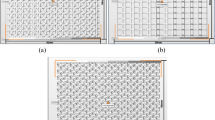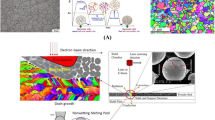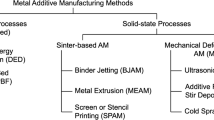Abstract
Nano powder injection molding is an appropriate technique for the mass production of micro components. However, the large surface area of nano powder increases the processing challenges, and as a result, nano/micro bimodal powder has been introduced into the process to reduce the problems. Although the understanding of the debinding behavior directly contributes to a fabrication of defect-free parts with a high production rate, most studies for the bimodal powder injection molding focused on the feedstock rheology and properties of sintered samples. In this study, nano powder effects on both of solvent and thermal debinding processes have been investigated with nano/micro bimodal feedstocks, and the master decomposition curve was developed. To prepare the bimodal feedstocks, premixed Fe nano/micro bimodal powders were blended with a wax-based binder system as the optimal volume ratios. Solvent and thermal debinding behaviors were analyzed by observing the weight change of the samples depending on the process time and temperature, respectively. The result indicated nano powder increased immersing time required in the solvent and the amount of the residual binder. It also narrowed the decomposition temperature range of the binder system by affecting the decomposition activation energy. From the result, the master decomposition curves of each bimodal feedstock were constructed and verified.
Similar content being viewed by others
References
Kate KH, Enneti RK, Atre SV (2017) Influence of feedstock properties on the injection molding of aluminum nitride. Int J Adv Manuf Technol 90:2813–2826
German RM, Bose A (1997) Injection molding of metals and ceramics. Metal Powder Industries Federation, Princeton
Attia UM, Alcock JR (2011) A review of micro-powder injection moulding as a microfabrication technique. J Micromech Microeng 21:043001
Rajabi J, Muhamad N, Sulong AB (2012) Effect of nano-sized powders on powder injection molding: a review. Microsyst Technol 18:1941–1961
Oh JW, Lee WS, Park SJ (2017) Influence of nano powder on rheological behavior of bimodal feedstock in powder injection molding. Powder Technol 311:18–24
Shearwood C, Fu YQ, Yu L, Khor KA (2005) Spark plasma sintering of TiNi nano-powder. Scripta Mater 52:455–460
Yu PC, Li QF, Fuh JYH, Li T, Ho PW (2009) Micro injection molding of micro gear using nano-sized zirconia powder. Microsyst Technol 15:401–406
Müller M, Bauer W, Ritzhaupt-Kleissl HJ (2005) Low-pressure injection molding of ceramic micro devices using sub-micron and nano scaled powders. Multi-material Micro Manufacture 1–4
Onbattuvelli VP, Enneti RK, Park SJ, Atre SV (2013) The effects of nanoparticle addition on SiC and AlN powder-polymer mixtures: packing and flow behavior. Int J Refract Met Hard Mater 36:183–190
Kate KH, Enneti RK, Onbattuvelli VP, Atre SV (2013) Feedstock properties and injection molding simulations of bimodal mixtures of nanoscale and microscale aluminum nitride. Ceram Int 39:6887–6897
Choi JP, Lyu HG, Lee WS, Lee JS (2014) Densification and microstructural development during sintering of powder injection molded Fe micro-nanopowder. Powder Technol 253:596–601
Choi JP, Lee GY, Song JI, Lee WS, Lee JS (2015) Sintering behavior of 316L stainless steel micro-nanopowder compact fabricated by powder injection molding. Powder Technol 279:196–202
Oh JW, Bollina R, Lee WS, Park SJ (2016) Effect of nano powder ratio in bimodal powder mixture on powder injection molding. Powder Technol 302:168–176
Rajabi J, Muhamad N, Sulong AB, Fayyaz A, Raza MR (2014) The effect of nano-sized stainless steel powder addition on mechanical and physical properties of micropowder injection molded part. Mater Des 63:223–232
Ani SM, Muchtar A, Muhamad N, Ghani JA (2014) Binder removal via a two-stage debinding process for ceramic injection molding parts. Ceram Int 40:2819–2824
Páez-Pavón A, Jiménez-Morales A, Santos TG, Quintino L, Torralba JM (2016) Influence of thermal debinding on the final properties of Fe-Si soft magnetic alloys for metal injection molding (MIM). J Magn Magn Mater 416:342–347
Kim SW (2010) Debinding behaviors of injection molded ceramic bodies with nano-sized pore channels during extraction using supercritical carbon dioxide and n-heptane solvent. J Supercrit Fluids 51:339–344
Aggarwal G, Park SJ, Smid I, German RM (2007) Master decomposition curve for binders used in powder injection molding. Metall Mater Trans A 38:606–614
Hidalgo J, Fernández-Blázquez JP, Jiménez-Morales A, Barriere T, Gelin JC, Torralba JM (2013) Effect of the particle size and solids volume fraction on the thermal degradation behaviour of Invar 36 feedstocks. Polym Degrad Stab 98:2546–2555
Calvert P, Cima M (1990) Theoretical models for binder burnout. J Am Ceram Soc 73:575–579
Barone MR, Ulicny JC (1990) Liquid-phase transport during removal of organic binders in injection-molded ceramics. J Am Ceram Soc 73:3323–3333
Tsai DS (1991) Pressure buildup and internal stresses during binder burnout: numerical analysis. AIChE J 37:547–554
Matar SA, Edirisinghe MJ, Evans JRG, Twizell EH (1993) The effect of porosity development on the removal of organic vehicle from ceramic or metal moldings. J Mater Res 8:617–625
Song JH, Evans JRG, Edirisinghe MJ, Twizell EH (2000) Optimization of heating schedules in pyrolytic binder removal from ceramic moldings. J Mater Res 15:449–457
Lam YC, Ying S, Yu SCM, Tam KC (2000) Simulation of polymer removal from a powder injection molding compact by thermal debinding. Metall Mater Trans A 31:2597–2606
Park SJ, German RM (2007) Master curves based on time integration of thermal work in particulate materials. IJMSI 1:128–147
Atre SV, Enneti RK Park SJ, German RM (2008) Master decomposition curve analysis of ethylene vinyl acetate pyrolysis: influence of metal powders. Powder Metall 51:368–375
Park SJ, Wu Y, Heaney DF, Zou X, Gai G, German RM (2009) Rheological and thermal debinding behaviors in titanium powder injection molding. Metall Mater Trans A 40:215–222
Shi Z, Guo ZX, Song JH (2002) A diffusion-controlled kinetic model for binder burnout in a powder compact. Acta Mater 50:1937–1950
Kissinger HE (1957) Reaction kinetics in differential thermal analysis. Anal Chem 29:1702–1706
Aggarwal G, Smid I, Park SJ, German RM (2007) Development of niobium powder injection molding. Part II: debinding and sintering. Int J Refract Met H 25:226–236
Aggarwal G, Park SJ, Smid I (2006) Development of niobium powder injection molding. Part I: feedstock and injection molding. Int J Refract Met H 24:253–262
Nishiyabu K (2012) Micro metal powder injection molding. In: Wang J (ed) Some critical issues for injection molding. InTech, Shanghai, pp 105–130
Sotomayor ME, Várez A, Levenfeld B (2010) Influence of powder particle size distribution on rheological properties of 316L powder injection moulding feedstocks. Powder Technol 200:30–36
Abbås KB (1981) Degradational effects on bisphenol A polycarbonate extruded at high shear stresses. Polymer 22:836–841
González-González VA, Neira-Velázquez G, Angulo-Sánchez JL (1998) Polypropylene chain scissions and molecular weight changes in multiple extrusion. Polym Degrad Stab 60:33–42
Colin X, Verdu J (2006) Polymer degradation during processing. C R Chim 9:1380–1395
Loh NH, Tor SB, Khor KA (2001) Production of metal matrix composite part by powder injection molding. J Mater Process Technol 108:398–407
Ibrahim MHI, Muhamad N, Sulong AB (2009) Rheological investigation of water atomised stainless steel powder for micro metal injection molding. IJMME 4:1–8
Cheng J, Wan L, Cai Y, Zhu J, Song P, Dong J (2010) Fabrication of W-20 wt. % Cu alloys by powder injection molding. J Mater Process Technol 210:137–142
Acknowledgements
We would like to acknowledge the financial support from the R&D Convergence Program of the Ministry of Science, ICT and Future Planning (MSIP) and National Research Council of Science and Technology (NST) of Republic of Korea (Grant B551179-12-02-00).
This work was supported by the National Research Foundation of Korea (NRF) grant funded by the Korea government (MSIP) (No. 2011-0030075).
Author information
Authors and Affiliations
Corresponding author
Rights and permissions
About this article
Cite this article
Oh, J.W., Lee, W.S. & Park, S.J. Investigation and modeling of binder removal process in nano/micro bimodal powder injection molding. Int J Adv Manuf Technol 97, 4115–4126 (2018). https://doi.org/10.1007/s00170-018-2263-8
Received:
Accepted:
Published:
Issue Date:
DOI: https://doi.org/10.1007/s00170-018-2263-8




